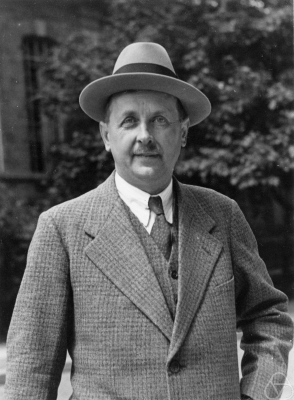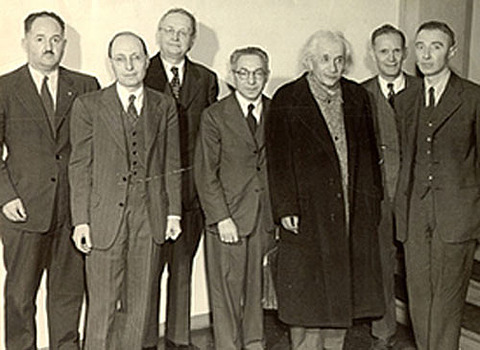Hermann Weyl: Work
Hermann Weyl’s work in mathematics was wide ranging, covered many fields, including integral equations, harmonic analysis, analytic number theory, and the foundations of mathematics. Weyl was also an influential figure in 20th century physics in the areas of relativity, electromagnetism, and quantum mechanics.

When Abraham Flexner, founding Director (1930–39) of the Institute for Advanced Study, was searching for mathematicians to join the Institute’s first Faculty, he went to Cambridge and met with G. H. Hardy, a prominent mathematician, for recommendations. Hardy suggested that among leading geometers in America, his choice was Oswald Veblen, but he said, “The greatest man in the field of geometry in Europe is Weyl.” Flexner reported that Albert Einstein was equally supportive, saying, “Weyl is preeminent.”
With Weyl’s appointment to the Faculty in 1933, on the heels of the appointments of Veblen and Einstein, Princeton replaced Göttingen as the world center for mathematics, and by providing exceptional conditions and opportunities to Faculty and visiting scholars, the Institute set an example for universities throughout the United States.
Early in his career, Weyl worked on the theory of numbers, singular integral equations, and functions of a complex variable. In 1913 he united function theory and geometry in his book Die Idee der Riemannschen Fläche Fläche (The Concept of a Riemann Surface), creating a new branch of mathematics. Weyl then moved to the study of the logical foundations of mathematics, and became interested in developing Einstein’s relativity theory and its generalizations. His contribution to the quantum theory of radiation was the invention of gauge fields. He is best known for his revolutionary advances in geometric function theory, the theory of compact groups, and theoretical physics.

“My own mathematical works are always quite unsystematic, without mode or connection,” Weyl said.
“I believe that, leaving aside my own peculiar nature, there is in mathematics itself, in contrast to the experimental disciplines, a character which is nearer to that of free creative art.”
In addition to his love of mathematics, Weyl had an interest in poetry, in symmetry in art, and in philosophy. He spent his first honorarium on a vellum copy of Thus Spake Zarathustra, according to his granddaughter Annemarie Carr, University Distinguished Professor of Art History at Southern Methodist University.
At the Institute, Weyl was instrumental in building the collection for the library and he became very involved with its operations, serving as head of the Library Committee. In January 1941, he wrote to then-Director Frank Aydelotte, “I wish you would have a look at the new contraption in our Library. Let the Trustees try it out themselves and climb to the platform of the ladder with a load of books! Quite seriously, I think it is actually dangerous.”
While at the Institute, the books he authored included Mind and Nature (1934), The Classical Groups (1939), Algebraic Theory of Numbers (1940), Meromorphic Functions and Analytic Curves (1943), an expanded version of Philosophy of Mathematics and Natural Science (1949), and Symmetry (1952). Among his many books is Philosophy of Mathematics and Natural Science, which Weyl originally wrote for a German-language encyclopedia in 1927. In it, he combined his love of philosophy and of mathematics as he examined how advances in philosophy were led by scientific discoveries. Language was important to him, and he once said, “Expression and shape mean almost more to me than knowledge itself.”
As he was about to retire in 1951, Weyl wrote to Institute Director J. Robert Oppenheimer, “Looking back, on this last day of my professorship, I do not feel particularly proud of what I accomplished, but I feel the deepest gratitude towards the fate and the men that brought me to the Institute in the fateful year 1933, and towards the colleagues whose help and friendship have made life and work enjoyable for me during all these years.”